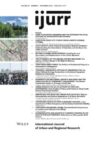The word paradise is of Iranian origin and refers to an enclosed garden space. In the Koran it is the permanent abode of the righteous. Its form, with flowing water, shade and fruits, is physically reproduced in gardens, mosques and carpets. The best examples of such reproduction were found in the sixteenth century, in the city of Esfahan. Today these structures still exist. How have they changed and what has remained intact? After a synopsis of Iranian history with our topic of paradise in mind, we investigate these two periods and present descriptive analyses. The objectification of the idea of ‘paradise’ is seen in the street names, and their perseverance to the present day shows the continuity of this symbol ever since the first written documents in Iran.
Details
Written by:
Soheila Shahshahani
Digital Object Identifier (DOI)
10.1111/1468-2427.00164
About DOI
Read full article as PDF
Read full article as HTML
See the references for this article
